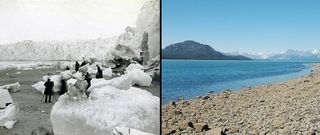What Can Climate Talks in Doha Accomplish?

The international community's attempts to address global warming, and its potentially devastating consequences, resume in earnest today (Nov. 26), as delegates gather in Doha, Qatar.
This is the latest round in two decades of U.N. climate talks that have sought to stem rising greenhouse gases in the atmosphere, which climate scientists warn will lead to devastating sea-level rise, changes in weather and other natural systems.
In 2009, at talks in Copenhagen, negotiators established a goal: Cut emissions enough to cap warming at 3.6 degrees Fahrenheit (2 degrees Celsius) above the pre-industrial average, and so avert the worst repercussions.
Over the next two weeks, negotiators will, once again, take a crack at closing the gap between this target and current emissions trajectories, which some worry have placed the planet on a track for considerably more warming and more devastating effects. [How 2 Degrees Will Change Earth]
Here are some of the main points negotiators are expected to tackle in Doha:
Cutting emissions before 2020 & beyond
In Copenhagen, three years ago, some nations made pledges to cut emissions by 2020. The United States, for instance, said it would cut its emissions to 17 percent below the level in 2005. However, as three successive U.N. Environment Programme (UNEP) reports have pointed out, even if nations meet these pledges, global emissions are on track to surpass the target in 2020.
Sign up for the Live Science daily newsletter now
Get the world’s most fascinating discoveries delivered straight to your inbox.
There are several potential ways to raise the level of ambition toward meeting this short-term goal, said Niklas Höhne, director of energy and climate policy at the independent research and consulting company Ecofys and a UNEP report author.
These include agreements by pledged countries to deepen their reductions; reductions from areas outside the realm of current national pledges, such as international transport; and pledges from new countries, including those in Middle East, Höhne said.
(Qatar, which is hosting this year's talks, emits the most carbon dioxide per capita in the world, according to World Bank figures. It did not make a pledge.)
Separately from these pledges, the Kyoto Protocol, an international treaty that required developed nations to cut emissions, may get new life in the short term. A small group of nations, including the European Union and Australia, may sign on to a second commitment period under the treaty.
The Kyoto Protocol's first commitment period expires this year. While the United States never signed on, other nations, including Canada, Japan and Russia, pulled out of the treaty.
And finally, there is a long-term agreement on the horizon. At Durban, a year ago, negotiators looked further into the future, laying the groundwork for a new agreement to be set up by 2015 and implemented in 2020. Many important details of this agreement remain to be resolved.
What needs to be done?
The nongovernmental group Climate Interactive has performed model simulations of the global energy system to look at possible pathways toward the warming cap. Their work has shown all successful pathways tend to include three components: more energy efficiency, more use of renewable energyand some kind of cost attached to carbon-dioxide emissions, Beth Sawin, the group’s co-director told LiveScience. [Top 10 Craziest Environmental Ideas]
Limiting carbon-dioxide emissions from deforestation and successfully limiting other greenhouse gases, such as methane and nitrous oxide, are also important, Sawin said.
"Without those elements, our model has difficulty producing pathways to 2 degrees [the cap on warming]," she said, adding, however, "if we are smart and start soon, the 2-degree goal seems to be within reach."
Part of the solution may come from outside the U.N. negotiation process, Höhne said.
He and colleagues, writing in the journal Nature Climate Changein an article published online in June, list 21 greenhouse-gas reducing initiatives for companies, cities and other entities, that cumulatively could put the 2-degree warming cap within reach.
These include emissions cuts by companies spearheaded by an association such as the World Business Council for Sustainable Development; and a coalition-led effort to reduce major cities' emissions.
"It has to be a combination of both," Höhne said of the top-down U.N. negotiation process and the sort of bottom-up efforts described in the paper. "Each one individually will not work."
The climate talks are scheduled to end Friday, Dec. 7.
Follow LiveScience on Twitter @livescience. We're also on Facebook & Google+.

